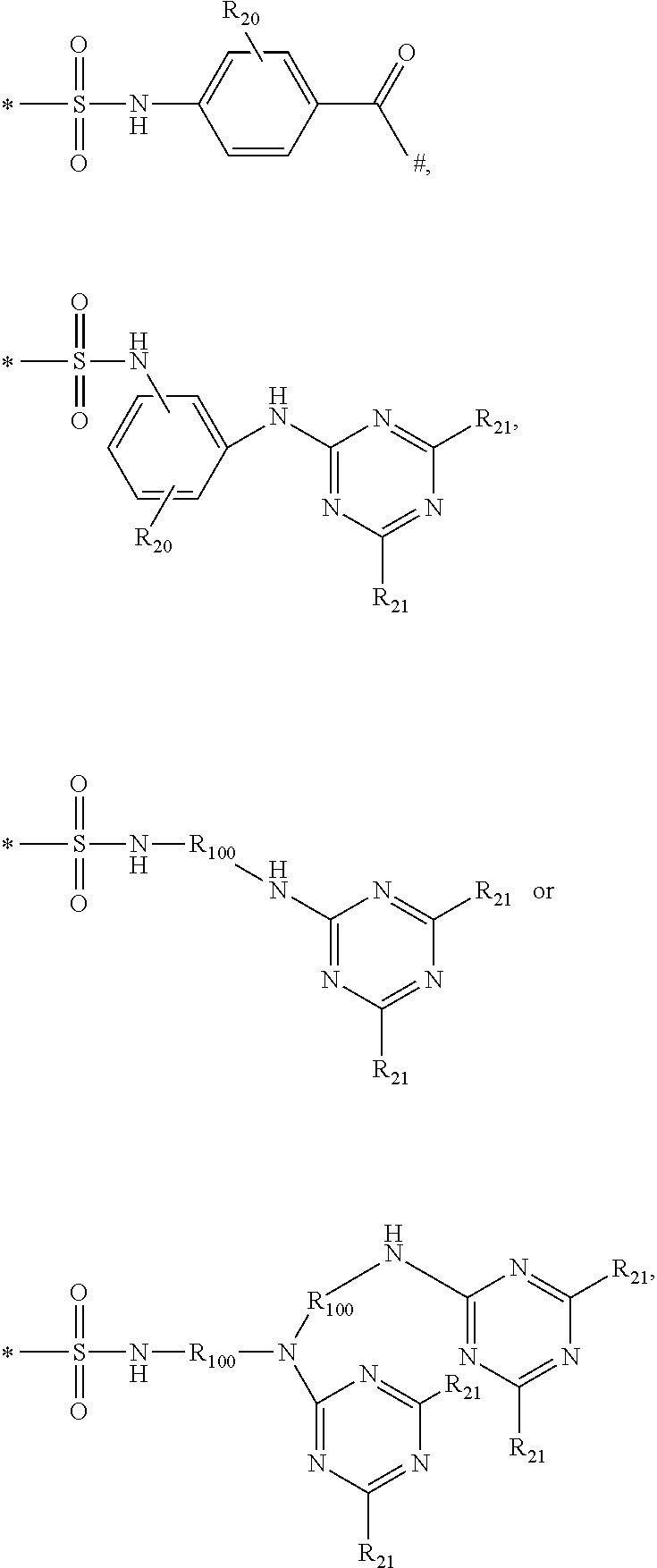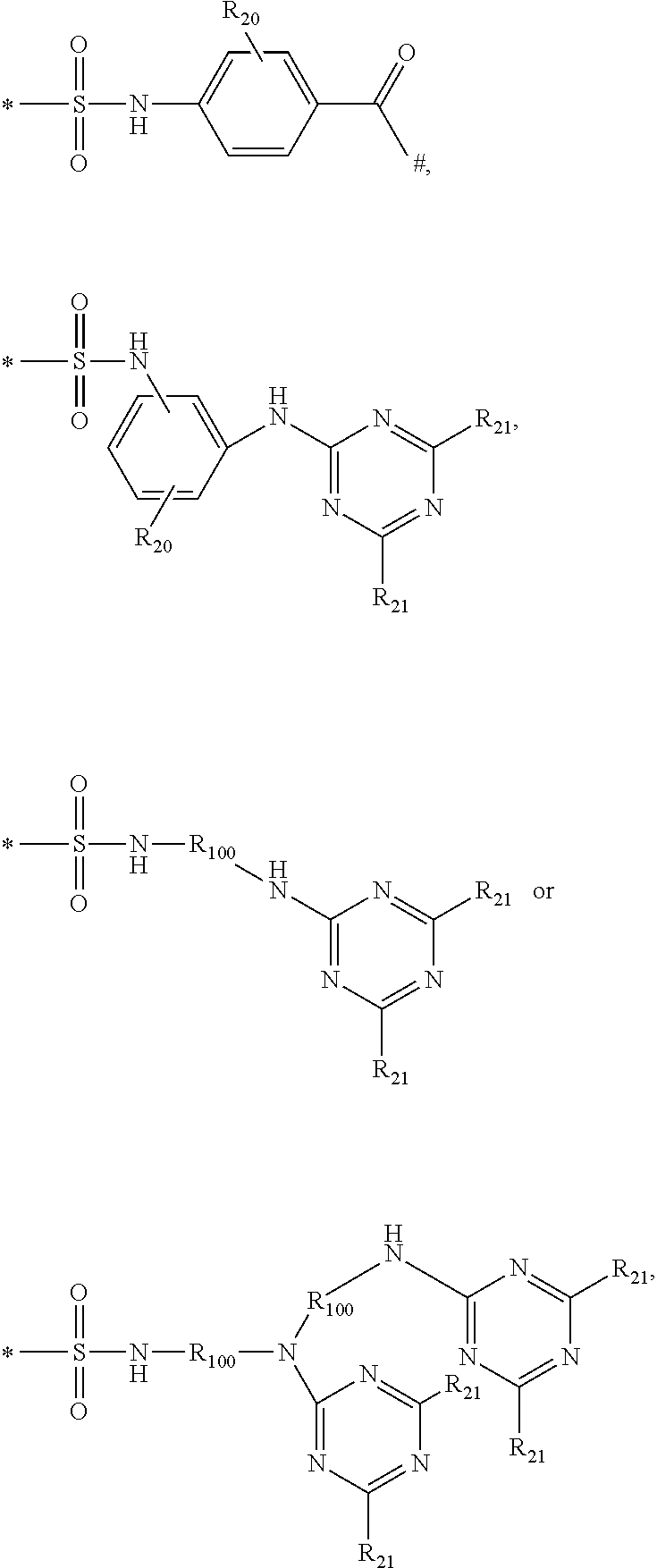Laundry detergent composition comprising particles of phthalocyanine compound
a technology of phthalocyanine and detergent, which is applied in the direction of detergent compounding agents, detergent compositions, chemical instruments and processes, etc., can solve the problems of coloured photo-activators, detergents that tend to stain laundry, and dissolve too slowly in water
- Summary
- Abstract
- Description
- Claims
- Application Information
AI Technical Summary
Benefits of technology
Problems solved by technology
Method used
Image
Examples
example 1
Encapsulated Dye Conjugate Product with Gelatine of Bloom 11
[0335]30 g gelatine of bloom 106 and 270 g gelatine of bloom 0 were dissolved in 875 g of the zinc(II) phthalocyanine dye conjugate solution obtained according to 1 e) at 62° C. under agitation. After 120 minutes, 45 g of coconut oil was added to the aqueous solution under slow agitation. The resulting mixture was then vigorously emulsified for 30 minutes while maintaining the temperature of around 60° C. The resulting dispersion was diluted with 350 g water.
[0336]Subsequently the diluted dispersion was atomized into a spray drying tower at about 80° C., where the dispersion particles were covered with a thin layer of powdering starch and dried at 40° C. for 150 minutes.
[0337]The resulting dry powder was sieved and the fraction 120 mesh to 60 mesh (ASTM E 11-70 (1995)) was collected and tested.
[0338]The final product had the following characteristics:
Bloom: 11, Spotting performance: 4, Wash performance: K / S=0.014
example 2
Encapsulated Dye Conjugate Product with Gelatine of Bloom 21
[0339]60 g gelatine of bloom 106 and 240 g gelatine of bloom 0 were dissolved in 1050 g of the zinc(II) phthalocyanine dye conjugate solution obtained according to 1 e) at 62° C. under agitation. After 120 minutes, 45 g of coconut oil was added to the aqueous solution under slow agitation. The resulting mixture was then vigorously emulsified for 30 minutes while maintaining the temperature of around 60° C. The resulting dispersion was diluted with 350 g water.
[0340]Subsequently the diluted dispersion was atomized into a spray drying tower at about 80° C., where the dispersion particles were covered with a thin layer of powdering starch and dried at 40° C. for 150 minutes.
[0341]The resulting dry powder was sieved and the fraction 120 mesh to 60 mesh (ASTM E 11-70 (1995)) was collected and tested.
[0342]The final product had the following characteristics:
Bloom: 21, Spotting performance: 3.5, Wash performance: K / S=0.014
example 3
Encapsulated Dye Conjugate Product with Gelatine of Bloom 32
[0343]90 g gelatine of bloom 106 and 210 g gelatine of bloom 0 were dissolved in 1250 g of the zinc(II) phthalocyanine dye conjugate solution obtained according to 1 e) at 62° C. under agitation. After 120 minutes, 45 g of coconut oil was added to the aqueous solution under slow agitation. The resulting mixture was then vigorously emulsified for 30 minutes while maintaining the temperature of around 60° C. The resulting dispersion was diluted with 480 g water.
[0344]Subsequently the diluted dispersion was atomized into a spray drying tower at about 80° C., where the dispersion particles were covered with a thin layer of powdering starch and dried at 40° C. for 150 minutes.
[0345]The resulting dry powder was sieved and the fraction 120 mesh to 60 mesh (ASTM E 11-70 (1995)) was collected and tested.
[0346]The final product had the following characteristics:
Bloom: 32, Spotting performance: 3, Wash performance: K / S=0.016
PUM
 Login to View More
Login to View More Abstract
Description
Claims
Application Information
 Login to View More
Login to View More - R&D
- Intellectual Property
- Life Sciences
- Materials
- Tech Scout
- Unparalleled Data Quality
- Higher Quality Content
- 60% Fewer Hallucinations
Browse by: Latest US Patents, China's latest patents, Technical Efficacy Thesaurus, Application Domain, Technology Topic, Popular Technical Reports.
© 2025 PatSnap. All rights reserved.Legal|Privacy policy|Modern Slavery Act Transparency Statement|Sitemap|About US| Contact US: help@patsnap.com



